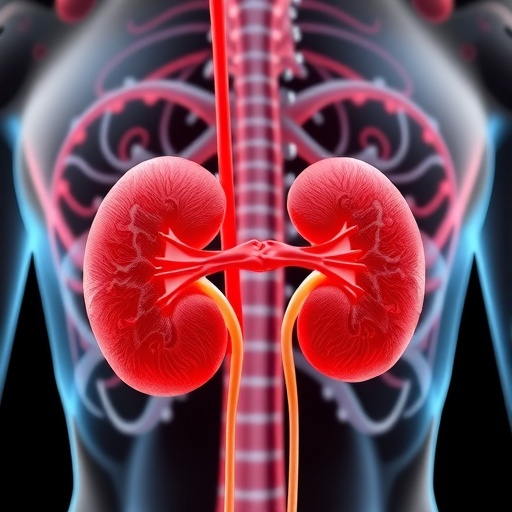In a groundbreaking study that reshapes our understanding of diabetic kidney disease progression, a team of scientists has unveiled the critical role of prolonged glucagon exposure in rewiring lipid oxidation pathways, ultimately accelerating kidney damage in diabetic patients. This discovery, published in Nature Communications, not only deepens the mechanistic insights into diabetic kidney disease (DKD) but also suggests novel therapeutic avenues targeting metabolic pathways to halt or reverse renal decline.
Diabetic kidney disease remains one of the most devastating complications of diabetes mellitus, with millions worldwide suffering from progressive renal failure leading to dialysis or transplantation. Traditionally, hyperglycemia-driven damage has been the primary focus of research; however, emerging evidence implicates dysregulated hormone signaling, especially involving glucagon, as a pivotal driver of renal pathology. Glucagon, a pancreatic hormone classically known for elevating blood glucose levels by promoting gluconeogenesis and glycogenolysis in the liver, is now being recognized for its broader metabolic repercussions.
This latest research dissects how chronic glucagon elevation, often observed in diabetes, rewires kidney metabolism by enhancing lipid oxidation pathways in renal tubular cells. Using advanced lipidomics and transcriptomic profiling, the researchers demonstrated that sustained glucagon exposure triggers a metabolic shift from glucose to fatty acid oxidation within the mitochondria. While fatty acid oxidation is an efficient ATP producer under normal conditions, its overactivation generates excessive reactive oxygen species (ROS), inducing oxidative stress and cellular injury.
This heightened oxidative environment propels a cascade of pathological changes, including mitochondrial damage, inflammation, and fibrosis, hallmark features of diabetic kidney disease progression. The team highlights that the glucagon-driven metabolic reprogramming exacerbates mitochondrial dysfunction, undermining the kidney’s capacity to maintain energy homeostasis and leading to structural and functional deterioration.
Notably, the study employed multiple in vivo and in vitro models to establish a causal link between prolonged glucagon signaling and DKD progression. Genetic mouse models with chronically elevated glucagon levels developed more severe tubular injury and interstitial fibrosis compared to controls, whereas pharmacological blockade of glucagon receptors attenuated these pathological changes. Parallel experiments in cultured human renal proximal tubular cells confirmed that glucagon stimulation enhanced fatty acid uptake and oxidation, inducing cellular stress responses.
These findings challenge the conventional glucose-centric view of diabetic kidney damage and elevate glucagon as a key metabolic hormone capable of directly modulating renal lipid metabolism. This represents a paradigm shift, suggesting that therapeutic strategies focusing solely on glucose control may be insufficient to fully tackle DKD. Instead, targeting glucagon signaling and its downstream metabolic pathways could provide a complementary and potentially more effective approach to preserve kidney function in diabetes.
The research also delves into the molecular regulators orchestrating this glucagon-induced metabolic remodeling. The team identified upregulation of peroxisome proliferator-activated receptor alpha (PPARα), a master regulator of fatty acid oxidation, in glucagon-exposed kidneys. Activation of PPARα stimulated expression of key enzymes involved in mitochondrial beta-oxidation, compounding the metabolic shift toward lipid catabolism. Additionally, alterations in AMP-activated protein kinase (AMPK) activity were implicated in the disrupted energy sensing contributing to mitochondrial stress.
Importantly, the translational significance of these discoveries is underscored by analyses of human kidney biopsy samples from diabetic patients. Elevated glucagon receptor expression and markers of enhanced lipid oxidation were correlated with worse renal function and more advanced histopathological features. This clinical association offers compelling evidence supporting the relevance of glucagon-mediated metabolic reprogramming in human DKD pathogenesis.
Moreover, the study raises important questions about the systemic metabolic environment in diabetes that perpetuates high glucagon levels. It is well-established that insulin deficiency and resistance not only impair glucose homeostasis but disinhibit alpha cell secretion of glucagon. This hyperglucagonemia thus constitutes a maladaptive endocrine loop exacerbating both hyperglycemia and renal metabolic disturbances.
Intriguingly, this research opens avenues to repurpose existing pharmacological agents that modulate glucagon activity. Glucagon receptor antagonists and inhibitors are already under investigation for type 2 diabetes treatment aimed at improving glycemic control. Their potential renoprotective properties, as suggested by this study, invite further exploration in clinical trials focused on diabetic kidney disease outcomes.
The researchers also emphasize the importance of dissecting tissue-specific effects of glucagon. While much attention has been given to hepatic glucagon action, its role in peripheral organs like the kidney merits more comprehensive investigation. The dual impact on both systemic metabolism and local tissue environments complicates the therapeutic targeting but also offers multiple intervention points.
Another dimension to consider is the interplay between glucagon-driven lipid metabolism and other metabolic substrates and pathways implicated in DKD. For instance, glucose, amino acids, and ketone bodies also undergo complex metabolic fates within renal tissues. Understanding how glucagon rewires broader metabolic networks is key to designing integrated strategies that restore metabolic balance without unintended consequences.
This study also highlights the critical involvement of mitochondrial dynamics and quality control mechanisms in diabetic kidney injury. Excessive fatty acid oxidation and ROS production induce mitochondrial fragmentation and impair mitophagy, further amplifying cellular stress. Therapeutics aimed at preserving mitochondrial integrity and function alongside glucagon pathway modulation could synergistically mitigate kidney damage.
Beyond direct metabolic effects, glucagon-mediated signaling may influence inflammatory and fibrotic pathways through metabolic-immune crosstalk. Lipid oxidation-derived metabolites can serve as signaling molecules modulating immune cell recruitment and activation. Consequently, glucagon-induced metabolic alterations might establish a pro-inflammatory microenvironment conducive to progressive renal fibrosis.
Future research directions include mapping the temporal sequence and dose dependence of glucagon’s effects on kidney metabolism and injury. Determining whether transient glucagon elevations have protective versus detrimental effects may reveal windows of therapeutic opportunity. Additionally, investigating patient heterogeneity in glucagon signaling and metabolic responsiveness could enable personalized interventions.
Ultimately, this comprehensive mechanistic insight into how prolonged glucagon exposure rewires lipid oxidation to accelerate diabetic kidney disease progression represents a major advance in the metabolic pathology of diabetes complications. It underscores the intricate hormonal and metabolic crosstalk governing renal health and disease, redefining glucagon from a glucose-raising hormone to a critical metabolic regulator with profound implications for diabetic kidney injury.
As diabetes prevalence continues to soar globally, innovations in understanding its complications at the molecular level are urgently needed. This study not only enriches our scientific comprehension but paves the way for novel metabolism-targeted therapies that could transform clinical management and improve outcomes for millions facing the daunting challenge of diabetic kidney disease.
Subject of Research: Prolonged glucagon exposure and its impact on lipid oxidation and diabetic kidney disease progression.
Article Title: Prolonged glucagon exposure rewires lipid oxidation and drives diabetic kidney disease progression.
Article References:
Liu, X., Chen, J., Gu, S. et al. Prolonged glucagon exposure rewires lipid oxidation and drives diabetic kidney disease progression. Nat Commun 16, 8561 (2025). https://doi.org/10.1038/s41467-025-63529-5
Image Credits: AI Generated
Tags: advanced lipidomics studieschronic glucagon exposurediabetes mellitus complicationsdiabetic kidney diseaseglucagon and kidney damagehyperglycemia and renal failurelipid oxidation pathwaysmechanistic insights into diabetes complicationsmetabolic pathways in diabetesrenal tubular cell metabolismtherapeutic targets for DKDtranscriptomic profiling in diabetes





